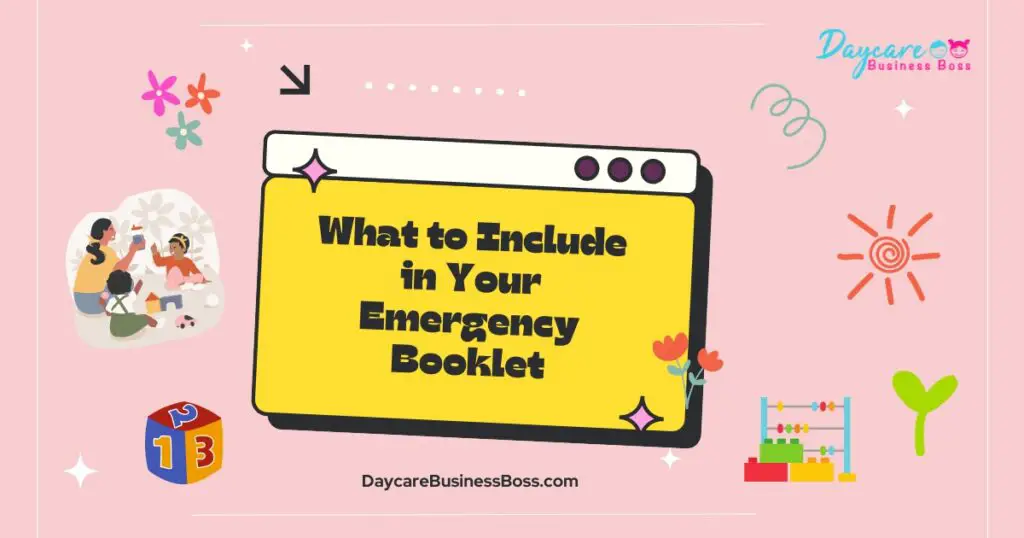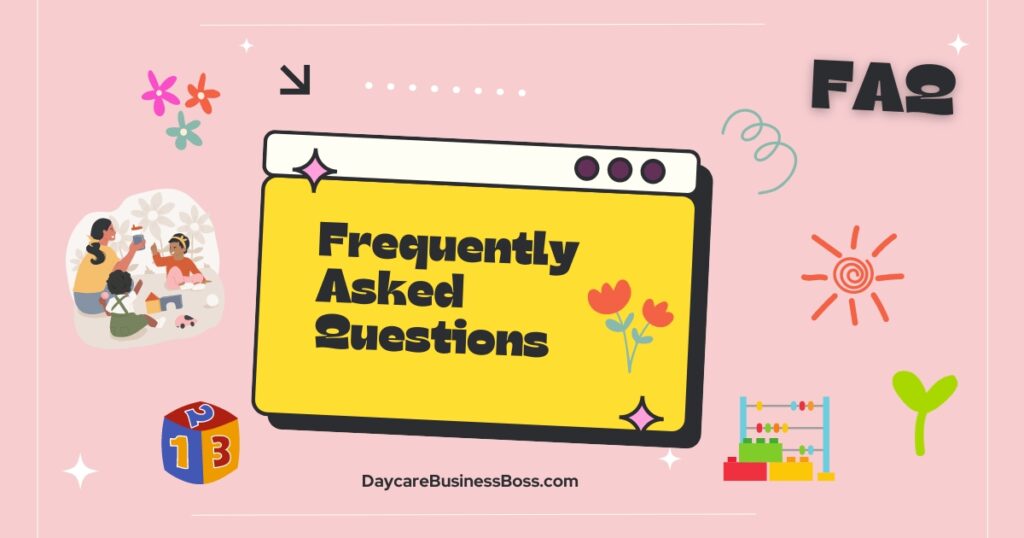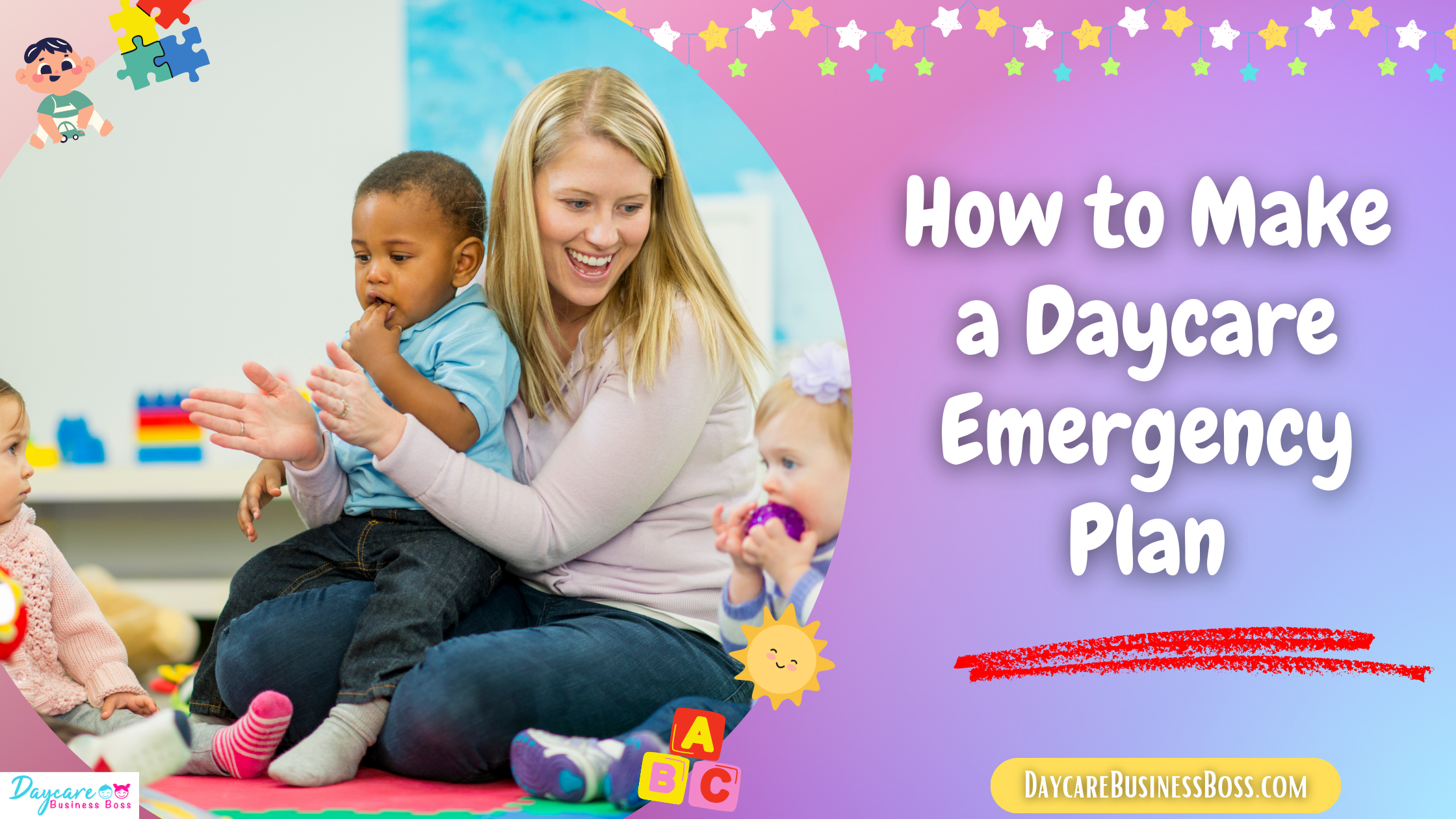Emergencies can happen even while you are running your daycare. Whether it is a tornado, flood, hurricane, or other natural disaster, you must prepare yourself as a Daycare Owner and your staff members for anything that can happen.
Create your daycare emergency plan by including:
- Local emergency contacts.
- General information about all the children in your care.
- Parent/guardian contact information for every child.
- Medical information for each child.
- An evacuation process.
- A shelter-in-place procedure.
- Emergency plan copies to send home with parents.
Create a daycare emergency plan today, so you always have it ready for those unexpected turn of events.
What if I Never Wrote an Emergency Plan Once in My Career?
No worries. There are plenty of daycare emergency plan templates available online for small business Daycare Owners to reference.
Check out this emergency daycare plan on FEMA to get you started writing up your daycare’s emergency plan today.
Guidelines for Practicing Emergency Drills
Daycare facilities and schools usually practice fire and evacuation drills once per month. Shelter-in-place drills should be practiced every 3 months.
To be even more prepared, you can have your facility practice fire and evacuation drills twice per month and practice shelter-in-place drills every 1-2 months. Going above and beyond will make sure that all teachers and staff know what to expect. If you practice these drills more than the minimum, the kids will catch on to the process to better prepare for a real emergency if it happens.
For efficient practice drills, follow these tips.
- Alert the children that the evacuation or shelter-in-place drill is starting.
- Direct them to the evacuation spot or safe haven in the classroom for the shelter-in-place drill.
- Inform the children to be expeditious yet as quiet as possible to keep order in the process.
- Infants should be placed in evacuation cribs or a multi-seater evacuation stroller, so they can be safely transported outside (evacuation procedure).
- Physically impaired children should be evacuated in wheelchairs.
- Let children know a day, a few hours, an hour, and 30 minutes in advance, so they are ready for the specific drill, so it does not come as a surprise to them when it starts.
What to Include in Your Emergency Booklet

Local Emergency Contacts
In the beginning of your plan, list all of the local emergency personnel contact numbers so they can be phone immediately when the type of emergency is determined.
List these emergency contacts in case a type of related emergency occurs.
- The electric company for electric outages during an emergency.
- The fire company if your daycare catches fire.
- The local Emergency Manager for guidelines on procedures to follow to get your children through a specific emergency if new staff is on board.
- Water company in case your daycare floods from leaky pipes.
- Poison control in case one of the kids ingest cleaning supplies.
- All of your insurance providers, so you can report damage claims to your daycare that occurred during an emergency.
- The gas company in case there is a gas leak at your facility.
While operations may be smooth and no emergencies come up for a long time, it does not mean an emergency will never come up. Stay on the safe side and have all of these contacts listed at the beginning of your emergency plan so no one has to waste extra time Googling the correct contact when the emergency happens. He or she can just refer to the emergency plan booklet and immediately place the call for assistance.
Child, Parent, and Medical Information
Sure, you have all your children’s information in your physical daycare files and a copy of said information in your daycare software. However, be sure to keep a copy of this valuable information in a copy of your daycare emergency plan as well.
Include the following to be sure you have everything to finish the child, parent, and medical information section.
- Child’s full name
- Birth date
- Age
- Teacher’s name
- Physical address
- Any special notes such as allergies and what comforts him/her
- Parent information
- 2-3 emergency contacts
- Medical information
- Doctor’s name, address, and phone number
- If applicable, any medication he/she is on
- If applicable, the child’s pharmacy information for prescription refills
Keeping this information handy in the emergency booklet will help with:
- Identifying children with allergies if an emergency falls around meal time.
- Learning how to comfort a child if he or she becomes scared during the emergency.
- Knowing what and how much medication a child should be taking for his/her condition.
- Contacting all of the parents to let them know about the emergency immediately as it happens.
- Staying in contact with a child’s medical provider should the need arise to call them during the emergency.
Evacuation Process
Outlining your evacuation process educates you, your staff, and your parents exactly how it will be done in the event of an emergency. Whether there’s a fire, gas leak, water leak, or other internal emergency that requires safe and expeditious exit from the facility, it’s important to have a detailed evacuation process that’s known and practiced so everyone is prepared for the unexpected.
Your evacuation plan should have:
- Regular evacuation routes and 2-3 alternative routes for each classroom and office in the building.
- A map detailing all of the fire exits and where alternative exits are located.
- Fire extinguisher locations.
- Fire pull emergency alarms
- Details about fire suppression supplies (sprinklers, smoke detectors, et cetera).
- Procedures for releasing children to parents once the evacuation has finished and all children have been accounted for.
For more information on how an evacuation process should be written, visit GSA.gov for a sample.
Shelter-in-Place Procedure
A shelter-in-place emergency could happen during a tornado or an intruder threat. Outline the procedure that all classrooms will follow in order to keep the children safe.
A general shelter-in-place procedure plan include:
- Emergency supplies teachers use for the event (red and green cards to show if they are ok or not ok, emergency kit, water bottles, et cetera)
- A designated place in each of the classrooms where teachers and children will hide away. This will usually be a closed off bathroom or in a far end of the classroom where windows do not point toward.
- How teachers will address the needs of students on medications while the shelter-in-place is commencing.
- How the needs of infants and toddlers will be addressed since they regularly need diapers and pull up change regularly and/or need more nourishment more so than older kids who can go longer without eating.
For more information on what you can include in the shelter-in-place portion of your emergency plan, visit here.
Send Copies of the Emergency Booklet Home to Parents
When you send copies of the emergency booklet home to all the parents, be sure NOT to include the student, parent/guardian, and medical information as this would be a breach of confidentiality. Cut this part out.
Include the local emergency contacts, evacuation process, and shelter-in-place procedure, so parents know how your daycare will be handling any type of emergency.
Conclusion
Get ready for any emergency situation today and finalize your emergency plan booklet. It’s vital for the safety of you, your staff, and the children that you serve at your facility. You will also be giving the parents peace of mind that your daycare facility is prepared for anything should an emergency happen while their child(ren) is/are in your care.
Related Questions

- Should I have an exact shelter-in-place plan for each type of natural disaster or possible emergency?
The shelter-in-place plan can be the same for every type of natural disaster such as a hurricane or a tornado. Maybe provide a few sentences at the end of the shelter-in-place section of your daycare emergency plan that outlines more details about how teachers and staff will keep children safe if there is an armed intruder in the building.
- Should I update my emergency plan?
Yes, update your emergency plan if:
- New students attend your facility. Include their information, parent information, and medical information into the daycare’s emergency booklet copy.
- You think of something else that should be included in your daycare’s emergency plan that’s pertinent to your area’s possible weather forecast or crime rate.
Please note: This blog post is for educational purposes only and does not constitute legal advice. Please consult a legal expert to address your specific needs.
After you have your Emergency plan ready, checkout our startup course and documents to move to the next step.

Meet Shawn Chun: Entrepreneur and Childcare Business Fan.
I’m a happy individual who happens to be an entrepreneur. I have owned several types of businesses in my life from a coffee shop to an import and export business to an online review business plus a few more and now I create online daycare business resources for those interested in starting new ventures. It’s demanding work but I love it. I do it for those passionate about their business and their goals. That’s why when I meet a childcare business owner, I see myself. I know how hard the struggle is to retain clients, find good employees and keep the business growing all while trying to stay competitive.
That’s why I created Daycare Business Boss: I want to help childcare business owners like you build a thriving business that brings you endless joy and supports your ideal lifestyle.


5 thoughts on “How to Make a Daycare Emergency Plan”
Comments are closed.